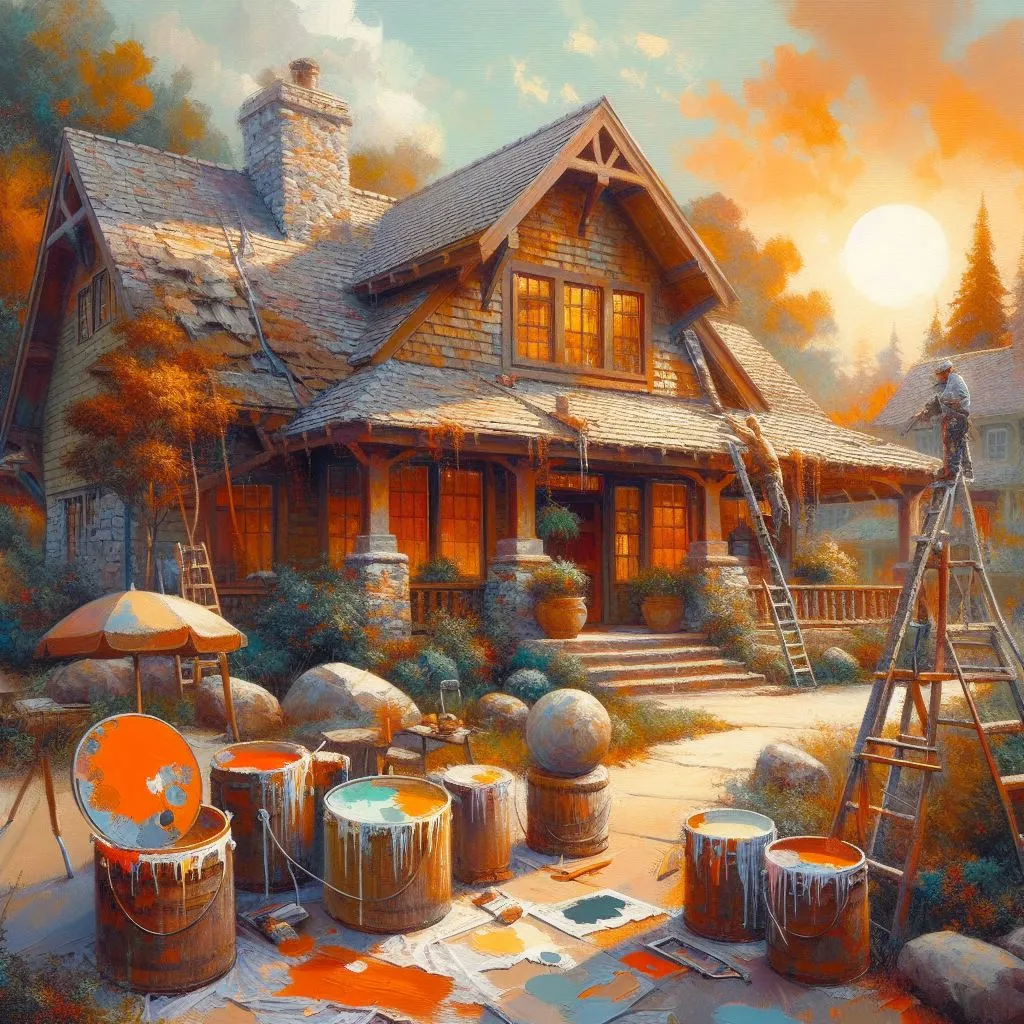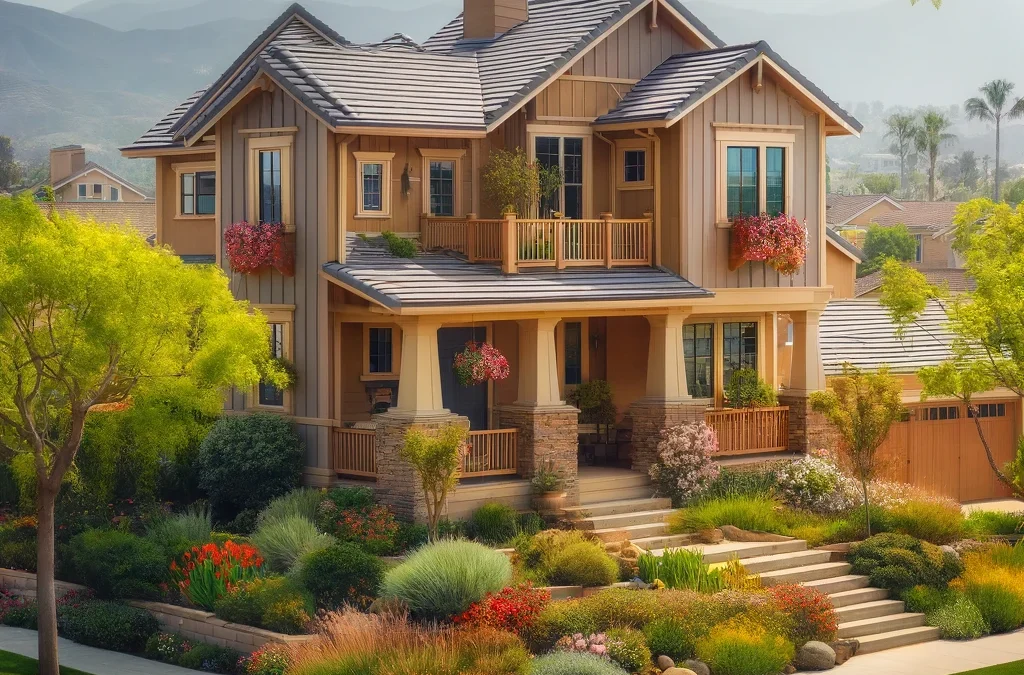Exterior house painting is a crucial aspect of home maintenance and improvement. It involves applying paint to the exterior surfaces of your home, such as the walls, doors, shutters, and trim. This not only enhances the aesthetic appeal of your home but also provides protection against weather elements and increases its value.
Maintaining the exterior of your home is essential for several reasons. First and foremost, it helps to preserve the structural integrity of your house. The exterior surfaces are constantly exposed to harsh weather conditions, such as rain, snow, UV rays, and temperature fluctuations. Over time, these elements can cause damage to the surfaces, leading to cracks, peeling paint, and even rotting wood. Regularly painting the exterior surfaces helps to create a protective barrier against these elements, preventing damage and extending the lifespan of your home.
Additionally, a well-maintained exterior enhances the curb appeal of your home. The exterior is the first thing people see when they approach your house, and a fresh coat of paint can make a significant difference in its overall appearance. Whether you’re planning to sell your home or simply want to create a welcoming atmosphere for yourself and your guests, exterior house painting can transform the look of your home and make it more visually appealing.
Key Takeaways
- Exterior house painting can transform the look of your home and increase its value.
- Benefits of exterior house painting include protection from weather damage and improved curb appeal.
- Choosing the right paint color for your home involves considering factors such as architecture, landscaping, and neighborhood style.
- Preparing your home for exterior painting involves cleaning, repairing, and priming surfaces.
- Hiring a professional painter is important for ensuring quality workmanship and avoiding costly mistakes.
Benefits of Exterior House Painting
There are numerous benefits to painting the exterior of your home. Let’s explore some of them in detail.
1. Protection against weather elements: As mentioned earlier, one of the primary benefits of exterior house painting is protection against weather elements. The paint acts as a shield, preventing moisture from seeping into the walls and causing damage. It also protects against UV rays that can fade and deteriorate surfaces over time. By investing in quality paint and regularly maintaining it, you can ensure that your home remains protected from these elements.
2. Increased curb appeal and home value: A fresh coat of paint can do wonders for the curb appeal of your home. It instantly gives your home a refreshed and well-maintained look, making it more attractive to potential buyers or visitors. In fact, studies have shown that homes with a fresh exterior paint job tend to sell faster and at a higher price than those without. So, if you’re looking to increase the value of your home, exterior house painting is a cost-effective way to do so.
3. Cost-effective home improvement: Compared to other home improvement projects, exterior house painting is relatively affordable and offers a high return on investment. It can completely transform the look of your home without breaking the bank. Instead of spending a significant amount of money on major renovations, simply painting the exterior can give your home a new lease on life. Additionally, regular maintenance and touch-ups can help prolong the lifespan of your paint job, saving you money in the long run.
Choosing the Right Paint Color for Your Home
Choosing the right paint color for your home’s exterior is an important decision that can greatly impact its overall appearance. Here are some factors to consider when making this choice.
1. Factors to consider when choosing a paint color: There are several factors to consider when choosing a paint color for your home’s exterior. First and foremost, consider the architectural style of your home. Certain colors may be more suitable for traditional or historic homes, while others may work better for modern or contemporary designs. Take into account the existing elements of your home, such as the roof color, landscaping, and surrounding environment. You want to choose a color that complements these elements rather than clashes with them.
Another factor to consider is the climate in which you live. Lighter colors tend to reflect heat and are therefore more suitable for warmer climates, while darker colors absorb heat and may be better suited for colder climates. Additionally, think about the overall mood or atmosphere you want to create with your home’s exterior. Do you want it to be vibrant and eye-catching, or more subdued and elegant? Consider your personal preferences and the overall aesthetic you’re trying to achieve.
2. Popular color trends for exteriors: Color trends for exteriors can vary from year to year, but there are some timeless options that never go out of style. Neutral colors, such as shades of white, beige, gray, and taupe, are always a safe choice and can create a classic and sophisticated look. These colors also tend to blend well with different architectural styles and surroundings.
However, if you’re looking to make a bold statement, consider opting for a pop of color. Deep blues, vibrant greens, and rich reds can add personality and character to your home’s exterior. Just be sure to choose a color that complements the existing elements of your home and doesn’t clash with the surrounding environment.
3. How to test paint colors before committing: Before committing to a paint color for your home’s exterior, it’s important to test it out first. Paint samples on small sections of your home’s exterior and observe how they look at different times of the day and in different lighting conditions. This will give you a better idea of how the color will appear on a larger scale.
Additionally, consider using online visualization tools or apps that allow you to digitally “paint” your home’s exterior using different colors. This can give you a better sense of how the final result will look before making a decision.
Preparing Your Home for Exterior Painting
| Task | Time Required | Difficulty Level |
|---|---|---|
| Washing the exterior walls | 2-4 hours | Easy |
| Scraping off old paint | 4-8 hours | Medium |
| Repairing damaged areas | 2-4 hours | Medium |
| Priming the surface | 2-4 hours | Easy |
| Choosing the right paint | N/A | Easy |
| Painting the exterior walls | 8-16 hours | Hard |
Properly preparing your home for exterior painting is crucial to ensure a smooth and long-lasting paint job. Here are some steps to follow when preparing your home for painting.
1. Cleaning and prepping the surface: Before applying any paint, it’s important to thoroughly clean the surfaces that will be painted. Use a pressure washer or a hose with a high-pressure nozzle to remove dirt, dust, and loose paint. Scrub the surfaces with a mild detergent and a stiff brush to remove any stubborn stains or grime. Rinse the surfaces thoroughly and allow them to dry completely before proceeding.
Once the surfaces are clean and dry, inspect them for any cracks, holes, or other damages. Fill these areas with an appropriate filler or caulk and smooth them out with a putty knife. Sand down any rough spots or uneven surfaces to create a smooth and even base for the paint.
2. Repairing any damages: In addition to filling cracks and holes, it’s important to address any other damages to the exterior of your home before painting. This may include repairing or replacing damaged siding, trim, or fascia boards. Inspect the surfaces for signs of rotting wood, insect infestation, or water damage. If you’re unsure how to properly repair these issues, it’s best to consult with a professional contractor who specializes in exterior repairs.
3. Covering and protecting surrounding areas: Before you start painting, it’s important to cover and protect any areas that you don’t want to be painted. This includes windows, doors, light fixtures, outdoor furniture, and landscaping. Use plastic sheeting or drop cloths to cover these areas and secure them in place with tape or clamps.
Additionally, consider removing any hardware or fixtures that can be easily detached, such as house numbers, door handles, and light fixtures. This will make the painting process easier and prevent accidental paint splatters on these items.
The Importance of Hiring a Professional Painter
While some homeowners may choose to tackle exterior house painting as a DIY project, there are several benefits to hiring a professional painter.
1. Benefits of hiring a professional: Professional painters have the knowledge, skills, and experience necessary to ensure a high-quality paint job. They are familiar with the best techniques and materials for different surfaces and can provide expert advice on color selection and paint finishes. They also have access to professional-grade tools and equipment, which can result in a more efficient and precise paint job.
Hiring a professional painter can save you time and effort. Painting the exterior of a house is a labor-intensive task that requires proper preparation, attention to detail, and a significant amount of time. By hiring a professional, you can free up your time to focus on other tasks or simply enjoy your weekends without the stress of a major home improvement project.
2. How to choose the right painter for your project: When choosing a professional painter for your exterior house painting project, it’s important to do your research and ask for recommendations. Look for painters who have experience with exterior painting and have a portfolio of their previous work. Read reviews and testimonials from past clients to get an idea of their reputation and the quality of their work.
It’s also important to obtain multiple quotes from different painters to compare prices and services. Keep in mind that the cheapest option may not always be the best choice. Consider factors such as experience, expertise, and customer reviews when making your decision.
3. What to expect during the painting process: When you hire a professional painter, they will typically follow a step-by-step process to ensure a successful paint job. This includes thorough surface preparation, including cleaning, repairing damages, and priming the surfaces if necessary. They will then apply multiple coats of paint using professional-grade tools and techniques to achieve a smooth and even finish.
During the painting process, you can expect some disruption to your daily routine. There may be some noise, odors, and limited access to certain areas of your home. However, a professional painter will strive to minimize these inconveniences and ensure that the project is completed as efficiently as possible.
Exterior Paint Finishes and Textures

Choosing the right paint finish for your home’s exterior is just as important as choosing the right color. The finish not only affects the overall appearance of your home but also plays a role in its durability and maintenance requirements. Here are some different types of paint finishes to consider.
1. Different types of paint finishes: There are several different types of paint finishes available for exterior surfaces, each with its own unique characteristics and benefits.
– Flat or matte finish: This finish has a low sheen and is ideal for hiding surface imperfections. It provides a smooth and uniform appearance but is less durable and more prone to staining and damage.
– Satin finish: This finish has a slight sheen and offers better durability and resistance to moisture, making it suitable for areas that are exposed to weather elements. It is also easier to clean than a flat finish.
– Semi-gloss finish: This finish has a higher sheen and provides excellent durability and moisture resistance. It is commonly used for doors, trim, and other high-traffic areas that require frequent cleaning.
– Gloss finish: This finish has the highest sheen and offers the greatest durability and moisture resistance. It is commonly used for metal surfaces, such as railings or gutters, as well as for accent features that you want to highlight.
2. How to choose the right finish for your home: When choosing a paint finish for your home’s exterior, consider factors such as the architectural style of your home, the surrounding environment, and your personal preferences.
For traditional or historic homes, a flat or matte finish can help to maintain the authenticity of the design. However, keep in mind that this finish may require more frequent touch-ups and maintenance.
For modern or contemporary homes, a satin or semi-gloss finish can provide a sleek and polished look. These finishes are also more durable and easier to clean, making them suitable for high-traffic areas.
3. Adding texture to your exterior with paint: In addition to choosing the right paint finish, you can also add texture to your home’s exterior using different painting techniques. This can create visual interest and enhance the overall aesthetic appeal of your home.
One popular technique is called “faux painting,” which involves creating the illusion of texture or material, such as stone or wood, using paint. This technique requires some skill and expertise, so it’s best to consult with a professional painter who specializes in faux finishes.
Another way to add texture is by using different tools or materials to create patterns or designs on the painted surface. For example, you can use a sponge or rag to create a mottled or stippled effect, or use a brush with stiff bristles to create a textured pattern.
Updating Your Home’s Curb Appeal with Painted Doors and Shutters
Painting your doors and shutters is a simple yet effective way to update your home’s curb appeal. Here are some benefits of painting these elements and tips for choosing the right color.
1. Benefits of painting doors and shutters: Painting your doors and shutters can instantly transform the look of your home’s exterior. It adds a pop of color and visual interest, making your home stand out from the rest. Additionally, painting these elements can help to protect them from weather elements and extend their lifespan.
2. Choosing the right color for your doors and shutters: When choosing a color for your doors and shutters, consider the overall color scheme of your home’s exterior. You want to choose a color that complements the existing elements, such as the siding, trim, and roof.
One popular trend is to choose a contrasting color for the doors and shutters that complements the main color of the house. For example, if your house is painted in a neutral color, such as beige or gray, you can opt for a bold color like red or navy blue for the doors and shutters. This creates a focal point and adds visual interest to your home’s exterior.
3. DIY vs. hiring a professional for this project: Painting doors and shutters can be a relatively simple DIY project, especially if you have some experience with painting. However, if you’re not confident in your painting skills or want to ensure a professional-looking finish, it’s best to hire a professional painter.
A professional painter will have the necessary tools and expertise to achieve a smooth and even finish. They can also provide guidance on color selection and offer advice on the best type of paint and finish for your doors and shutters.
Painting Techniques for Unique Architectural Features
 If your home has unique architectural features, such as columns, trim, or moldings, painting them requires some special techniques. Here are some tips for achieving a professional-looking finish on these elements.
If your home has unique architectural features, such as columns, trim, or moldings, painting them requires some special techniques. Here are some tips for achieving a professional-looking finish on these elements.
1. How to paint unique architectural features: When painting unique architectural features, it’s important to pay attention to detail and use the right tools and techniques. Here are some tips to keep in mind:
– Use a small brush or an angled brush to reach tight corners and edges. This will help you achieve a precise and clean finish.
– Apply painter’s tape along the edges of the feature to create crisp lines and prevent paint from bleeding onto adjacent surfaces.
– Use a steady hand and take your time when painting intricate details, such as moldings or carvings. This will ensure that the paint is applied evenly and doesn’t obscure the details.
– Consider using a primer before applying the paint, especially if the surface is porous or has a lot of imperfections. A primer helps to create a smooth and even base for the paint to adhere to, resulting in a more professional and long-lasting finish. It also helps to seal the surface, preventing any stains or discoloration from bleeding through the paint. Additionally, a primer can improve the coverage and durability of the paint, allowing it to withstand everyday wear and tear. Overall, using a primer before applying paint can greatly enhance the final result and ensure that the paint job lasts for years to come.
If you’re looking for professional house painters in Newport Beach, Orange County, or Santa Ana, we have just the article for you! Our related article discusses the importance of hiring experienced painters for your exterior house painting project. Learn why it’s crucial to choose skilled painters who can handle the unique challenges of painting the exterior of your home. To find out more, check out our article on Newport Beach house painters, Orange County house painters, and Santa Ana house painters.
FAQs

What is exterior house painting?
Exterior house painting is the process of applying paint or other protective coatings to the exterior surfaces of a house or building.
Why is exterior house painting important?
Exterior house painting is important for several reasons. It helps protect the exterior surfaces of a house from weather damage, such as rain, wind, and sun. It also helps improve the curb appeal and overall appearance of a house.
What are the benefits of exterior house painting?
The benefits of exterior house painting include protecting the exterior surfaces of a house from weather damage, improving the curb appeal and overall appearance of a house, and increasing the value of a house.
How often should exterior house painting be done?
The frequency of exterior house painting depends on several factors, such as the type of paint used, the climate, and the condition of the exterior surfaces. Generally, exterior house painting should be done every 5-10 years.
What are the steps involved in exterior house painting?
The steps involved in exterior house painting include preparing the surfaces to be painted, such as cleaning and sanding them, applying primer, applying the paint, and allowing the paint to dry.
What types of paint are used for exterior house painting?
There are several types of paint that can be used for exterior house painting, including latex, oil-based, and acrylic paints. The type of paint used depends on the specific needs of the house and the preferences of the homeowner.
Can exterior house painting be done in any weather?
Exterior house painting should not be done in extreme weather conditions, such as high humidity, rain, or extreme heat. The ideal weather conditions for exterior house painting are dry, mild, and sunny.
Page Design by: Website Design and Marketing Near Me


